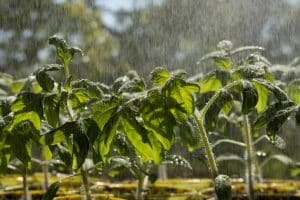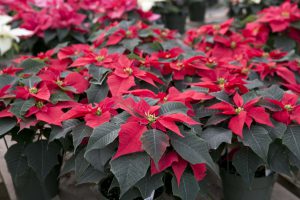
Secrets to Healthy Soil (or – The Difference between Dirt and Soil)
by Rob Sproule
Dirt or Soil?
It’s an old joke in the greenhouse “˜biz’ that when someone says “dirt”, you correct them and say, “we call it soil, here.” Both people chuckle (or groan) because we know that they’re two words for the same thing”¦ right?
Wrong. There is a vast difference between soil and dirt, a difference that encapsulates many the debates and choices that gardeners wrestle with. Soil is a dynamic, living environment. It teems with billions of bacteria, fungi, protozoa and nematodes per teaspoon. Soil is the complex cradle that supports and nourishes all life on this planet either directly or indirectly. Soil is magical, and as essential to our lives as the atmosphere.
Dirt is largely dead. Without the web of life that soil has, it’s an inner vessel and the only way to grow anything in it is to add synthetic fertilizers and chemicals, which in turn keep the dirt from becoming healthy soil.
Large-scale agricultural methods are based on how to grow crops in dirt. Permaculture is about fostering and embracing soil.
Wean Yourself off Chemicals
It’s in our nature to help. When it comes to soil, often we can help most by doing less. Nature has its processes all figured out, and the best thing we can do for our soil is to allow those processes to function.
By now it goes without saying that the less chemicals we dump into our yard, the better. Creating a backyard ecosystem that self-regulates pests via resident predators is a different mindset than the established “nuke’em’all” knee jerk reaction that has long dominated mainstream gardening. Pesticides and herbicides not only wipe out predators as well as pests, they pretty much ensure that the next outbreak will be worse given that aphids and spiders take a lot longer to bounce back than aphids and mites.
You can’t have healthy soil without creepy-crawlies. Lots of them. The vast majority of them are microscopic and almost always beneficial. Under the surface of our yards, bacteria and nematodes work incessantly to transform nutrients and make them available to plant roots. In a union of chemistry and biology, these teeming critters are the gatekeepers of life, and without them plants wouldn’t be able to absorb the elements they need to thrive.
Over time, unchecked chemical use will turn thriving soil into lifeless dirt. This creates a dependence on synthetic fertilizers (which is all too common in modern agricultural techniques), which in turn often inhibit microorganisms from re-establishing themselves.
Avoid excessive fertilizer use, especially when it comes to the water-solubles (the ones that turn the water blue). Fertilizers with high middle numbers (phosphorus) can burn fragile mircoorganisms. Given that high-phosperous fertilizers are really only needed for high-performance annuals, like trailing petunias and verbenas, keep these annuals confined to container gardens and safely separated from your soil.
Never exceed the dosage recommended on fertilizer bottles. Doing so will leech excessive amounts of chemicals into waterways, will waste your money, and will do nothing extra for the plant. If possible, move away from synthetic, water-soluble fertilizers and towards organics.
Dig with Care
It surprises most people to learn that over-working soil can actually degrade the soil-based ecosystem. Rototilling is fairly destructive to soil because it exposes microorganisms to excessive amounts of oxygen (which causes increased decomposition), chops up valuable earthworms, and brings buried weed seeds to the surface. While most think tilling decreases weeds, it actually does the opposite.
Only till, fork, and shovel your soil when necessary (ie. to add manure or sea-soil to enrich in the early spring). Other than necessary digging, leave the tools in the shed and save your back. Soil does best when it’s left on its own. Nature has an amazing capacity to correct itself if we just leave it be.
Foot Traffic
Air pockets are vital to healthy soil. Microorganisms need oxygen to survive and delicate, fibrous roots need porous surroundings in order to expand. Every time you step in your garden, your shoe or boot is a giant stamp that crushes air pockets under it.
Avoid excessive foot traffic in your veggie and flowerbeds, especially after its rained or you’ve watered. Consider laying 2×8 boards between your rows of vegetables. Standing/walking on these will reduce soil compaction and it’s an excellent weed suppressant.















